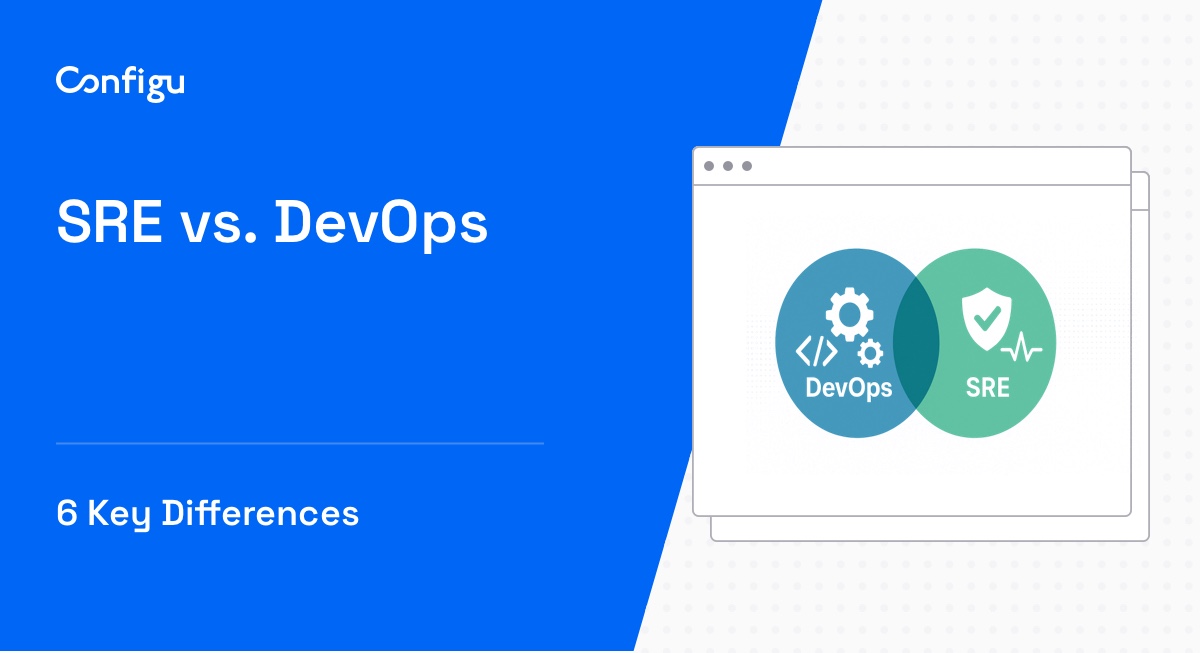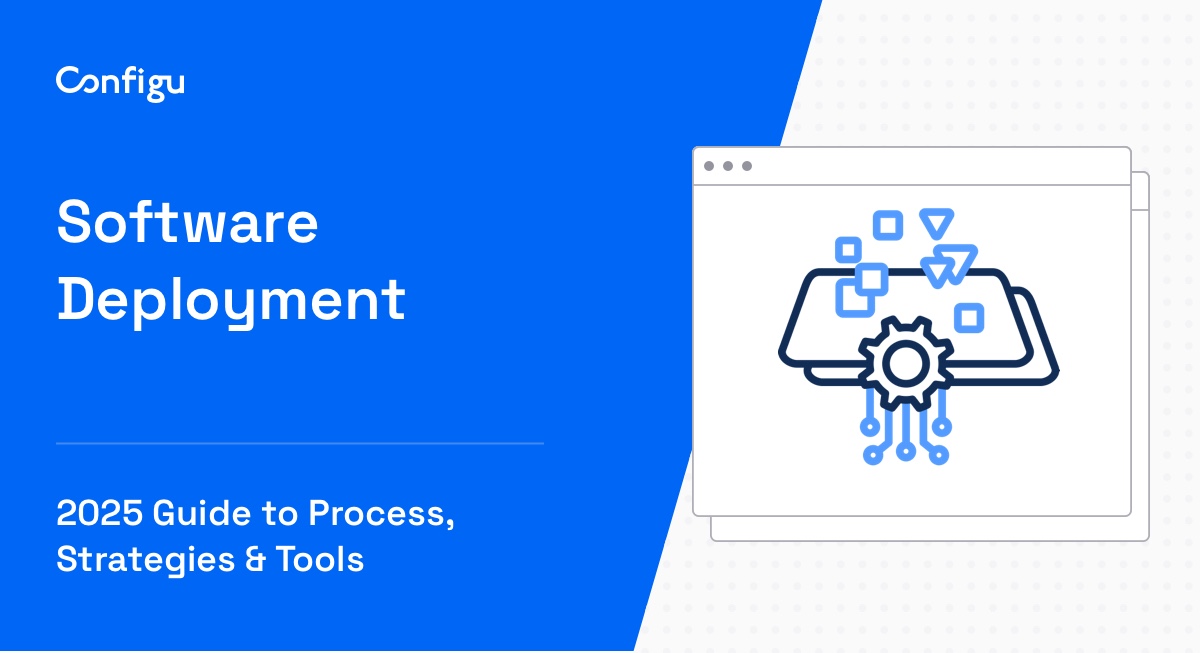What Is a DevOps Pipeline?
A DevOps pipeline is a series of stages in software development automating processes for continuous integration, delivery, and deployment (CI/CD). It improves collaboration between development and operations teams, simplifying workflows and ensuring faster delivery of updates.
By implementing automation, DevOps pipelines allow for frequent code changes, reducing human error and improving efficiency. They integrate various development, testing, and deployment stages into a cohesive workflow, adhering to the best practices of agile and DevOps methodologies.
The pipeline’s objective is to enable continuous software improvement with minimized manual interventions. Tools like Jenkins, GitLab CI, and AWS CodePipeline support DevOps pipelines, offering integrations and automated operations for increased productivity. They help reduce the time taken from code commit to deployment, maintaining product quality and performance.
In this article:
Key Concepts in DevOps Pipelines
Continuous Integration
Continuous integration (CI) is a principle in DevOps pipelines where developers frequently commit code changes to a shared repository. Automated builds and tests are conducted every time a change is made, ensuring that code integrations are smooth and without conflict. This practice reduces integration issues, speeds up development cycles, and maintains system stability by identifying problems early.
CI tools like Jenkins, Travis CI, and CircleCI automate processes, enabling immediate feedback on code quality. The ability to detect errors early in the development cycle transforms software delivery, mitigating risks, and improving overall project efficiency. Continuous addition and testing of code ensure that the software remains in a release-ready state.
Continuous Delivery and Deployment
Continuous delivery (CD) extends CI, ensuring that code changes are automatically prepared for release to production. This involves rigorous automated testing, allowing teams to confidently deploy software at any time. Continuous deployment further automates this process, pushing code changes directly to production environments.
DevOps teams use tools like Jenkins, Spinnaker, and AWS CodeDeploy to automate deployments, minimizing downtime and ensuring consistent updates. Continuous delivery and deployment closely align development and operations, supporting business agility. By achieving faster release cycles, teams can innovate and adapt to user feedback.
Continuous Testing
Continuous testing involves the automated execution of tests throughout the software delivery pipeline, ensuring code quality and faster feedback. This practice is integral from the development phase through to production, identifying and resolving defects early. Tools like Selenium, Appium, and TestComplete offer test coverage across units, integration, and user acceptance levels.
Implementing continuous testing leads to more reliable software and reduces the likelihood of defects in production. The integration of testing frameworks within CI/CD pipelines verifies code constantly, allowing teams to focus on feature development rather than firefighting issues.
Continuous Feedback and Monitoring
Continuous feedback and monitoring provide insights into system performance and user experience through real-time data collection. This process involves using tools like Prometheus, Grafana, and New Relic to gather metrics and log files, transforming them into actionable insights.
By integrating feedback loops within pipelines, teams can respond quickly to performance issues or feature demands. Leveraging continuous feedback ensures that development aligns with user expectations. Monitoring enables proactive issue detection, reducing troubleshooting time and improving operational stability.
Continuous Operations
Continuous operations ensure constant availability and stability within a DevOps environment. This approach emphasizes automation in infrastructure management, scaling, and recovery tasks to maintain uptime and performance. Tools like Kubernetes and Docker orchestrate resources efficiently, supporting uninterrupted workflow amidst varying demand.
By prioritizing continuous operations, organizations reduce risks associated with manual interventions, achieving resilient and self-healing systems. This reliability fosters user trust and supports deployment processes, even in complex environments.
Learn more in our comprehensive GitOps guide.
Tips From the Expert
In my experience, here are tips that can help you better implement and optimize a DevOps pipeline:
- Adopt pipeline-as-code for reproducibility: Define and manage your entire pipeline as code using tools like GitHub Actions YAML files or Jenkins Pipeline DSL. This ensures consistent pipeline configurations across environments and simplifies updates or versioning.
- Incorporate dynamic environments for testing: Use tools like Kubernetes namespaces or Docker containers to spin up isolated, ephemeral environments dynamically for each pipeline run. This enables realistic, concurrent testing without interfering with other environments.
- Segment pipelines into modular stages: Break the pipeline into distinct, reusable stages (e.g., build, test, deploy) that can be shared across projects. This modularity allows teams to quickly adopt and adapt pipelines for new applications without starting from scratch.
- Implement gated deployments with manual approvals: For high-risk environments like production, configure gates that require manual approval before deployment. This balances automation with control in sensitive scenarios, ensuring compliance and risk management.
- Integrate performance testing early in the pipeline: Don’t wait until the end of the pipeline to test performance. Tools like Apache JMeter or k6 can run lightweight performance tests during early stages, catching issues before full-scale deployment.
Phases of a DevOps Pipeline
DevOps pipelines typically include the following phases, although individual pipelines may differ based on the organization’s objectives.
Plan and Collaborate
The planning and collaboration phase involves initial project setup, requirements gathering, and defining objectives. This phase manages expectations and aligns team goals, fostering clear communication channels. Tools like Jira, Trello, and Confluence support task management, ensuring everyone is on the same page.
Collaboration encourages cross-functional teamwork, involving developers, operations, and stakeholders. Open dialogue and integrated workspaces ensure alignment on product vision. This phase plays a crucial role in identifying resources, timelines, and risks, preparing teams for project progression.
Code and Build
The coding and building phase covers writing source code and transforming it into deployable applications. This step involves using version control systems like Git to manage code repositories and collaboration. Post code submission, automation tools compile and test the software, ensuring that it passes predefined criteria before progressing further in the pipeline.
By automating builds with tools such as Maven or Gradle, teams achieve consistent and reliable results, reducing the possibility of discrepancies. This phase tests the code’s functionality, identifying issues at an early stage, and ensuring that the product is ready for further validation and deployment stages.
Test and Validate
Testing and validation ensure code meets quality standards before deployment. Automated tests check for functionality, performance, and security, using tools like Selenium and JUnit to perform these evaluations promptly. Thorough testing in this phase reduces defects, cutting costs associated with post-deployment bug fixes.
Validation extends beyond technical requirements, confirming that software aligns with business objectives and user needs. This phase is integral for maintaining software integrity, with every code change being tested to prevent regressions and maintain product stability.
Release and Deploy
The deployment phase focuses on pushing vetted code into production environments. This phase requires automated tools like Ansible and Chef to ensure deployments are efficient, reliable, and quick. Automating this phase decreases downtime during releases, providing users with uninterrupted services or minimal disruption during updates.
Dynamic deployment strategies, such as blue-green or canary deployments, help minimize risks associated with new releases. By prepping production-ready environments, the release phase transitions smoothly, with rollback options reducing potential impacts of unsuccessful deployments.
Operate and Monitor
The operate and monitor phase involves ongoing system management and performance tracking post-deployment, using tools like Nagios and Prometheus. This phase detects anomalies, optimizes performance, and ensures compliance with service-level agreements, maintaining system reliability and improving operational efficiency.
Logging and alerting systems provide continuous insights into application health, allowing teams to proactively address issues. Consistent monitoring supports continuous improvement cycles, providing feedback for future development iterations.
Best Practices for Implementing DevOps Pipelines
Organizations should consider the following practices to ensure an effective DevOps pipeline.
1. Implement Automation Throughout the Pipeline
Automation is essential for DevOps implementation, eliminating repetitive tasks and reducing manual errors. By automating processes across development, testing, deployment, and monitoring stages, teams maintain a consistent and efficient workflow. Tools like Jenkins, Selenium, and Ansible serve as automation enablers, simplifying operations.
Continuous automation improves reliability and speeds release cycles, allowing teams to focus on strategic development goals. Automation also supports scalability and adaptability within environments, supporting dynamic user demands and rapid feature iteration.
2. Use Infrastructure as Code
Infrastructure as code (IaC) simplifies infrastructure management through code-based configuration and automation. IaC tools like Terraform and CloudFormation define infrastructure components programmatically, enabling reproducibility and version control. This approach supports deployment consistency, reducing setup time and configuration divergences.
IaC also improves scalability and disaster recovery capabilities by storing infrastructure configurations in versioned repositories. It ensures that environments can be recreated or modified swiftly in line with changing project demands.
3. Ensure Security and Compliance
Enforcing security and compliance within pipelines protects applications and user data from breaches and legal issues. Regular auditing, vulnerability scanning, and automated compliance checks, using tools like OpenSCAP and Chef InSpec, maintain system integrity and regulatory adherence. This practice protects operations against evolving cyber threats.
Incorporating security protocols at every stage of the pipeline mitigates risks, fostering user trust and business continuity. Comprehensive security strategies improve application resilience, supported by regular updates and patches.
4. Optimize Pipeline Performance
Optimized pipelines ensure efficient, fast, and reliable delivery cycles. This involves identifying and eliminating bottlenecks, balancing resource allocation, and refining automation workflows. Techniques like parallelizing tasks, caching dependencies, and optimizing build tools (e.g., by using Docker or Bazel) significantly improve execution speed.
Performance monitoring tools like New Relic and Datadog provide insights into pipeline metrics, enabling teams to address inefficiencies proactively. Reducing pipeline complexity, such as by minimizing unnecessary stages or redundant tests, ensures smoother operations. Regular audits and updates to tools and processes also keep the pipeline aligned with best practices.
5. Standardize Processes and Documentation
Standardizing processes and documentation fosters consistency, repeatability, and scalability in DevOps pipelines. Well-defined workflows and guidelines help teams navigate development, testing, and deployment phases without ambiguity. Tools like Confluence or GitHub Wiki serve as centralized repositories for documentation, ensuring accessibility and collaboration.
Process standardization reduces onboarding time for new team members and minimizes errors caused by miscommunication or ad hoc practices. Establishing clear conventions for coding, testing, and infrastructure management improves productivity. Version-controlled documentation ensures that changes to processes are transparent and traceable.
Related content: Read our guide to DevOps on cloud (coming soon)
Automating Configurations with DevOps Pipelines Using Configu
Configu is a configuration management platform comprised of two main components:
Configu Orchestrator
As applications become more dynamic and distributed in microservices architectures, configurations are getting more fragmented. They are saved as raw text that is spread across multiple stores, databases, files, git repositories, and third-party tools (a typical company will have five to ten different stores).
The Configu Orchestrator, which is open-source software, is a powerful standalone tool designed to address this challenge by providing configuration orchestration along with Configuration-as-Code (CaC) approach.
Configu Cloud
Configu Cloud is the most innovative store purpose-built for configurations, including environment variables, secrets, and feature flags. It is built based on the Configu configuration-as-code (CaC) approach and can model configurations and wrap them with unique layers, providing collaboration capabilities, visibility into configuration workflows, and security and compliance standardization.
Unlike legacy tools, which treat configurations as unstructured data or key-value pairs, Configu is leading the way with a Configuration-as-Code approach. By modeling configurations, they are treated as first-class citizens in the developers’ code. This makes our solution more robust and reliable and also enables Configu to provide more capabilities, such as visualization, a testing framework, and security abilities.



